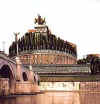

S. Angelo castle
|
This enormous impressive circular construction was built by emperor Hadrian in 130-139 as a mausoleum for himself and his family in substitution of one, already built on the opposite side of the Tiber by emperor Augustus. The height is nearly 50m, the design belongs to Hadrian. The mausoleum consisted of a base 89m sq., supporting a round tower 64m in diameter of peperino and travertine overlaid with marble. Above this was an earthen tumulus planted with cypress trees. At the top was an altar bearing a bronze quadriga driven by a charioteer representing Hadrian, as the Sun, ruler of the world. Inside the building is a spiral ramp, which led to a straight passageway ending in the cella, in which was the Imperial tomb. Hadrian and Sabina (his wife) were buried in the mausoleum, as were succeeding emperors until Septimus Severus in 175.
|
|
|
Julius II built the south loggia, facing the river. When Clement VII and some 1000 followers (including 13 cardinals and 18 bishops) took refuge here in 1527 from the troops of Charles V, Benvenuto Cellini took part in its defense. Paul III built the north loggia and decorated the interior with frescoes. The outer ward, with its defensive ditch, was added by Pius IV. Urban VIII provided the castle with cannon made of bronze taken from the ceiling of the Pantheon portico, and he employed G.L.Bernini to remodel the outer defenses. From 1849 to 1870 the castle was occupied by French troops. Under the Italian Government it was used as barracks and as a prison until 1901, when the work of restoration was begun. In 1933-34 the castle was adapted for use as a museum (58rooms) and the surrounding area was cleared. According to the tradition the fireworks were invented by Michelangelo and brought to perfection by G.L.Bernini. Till the end of 19th century the fireworks were activated on the holidays and special occasions. Castel S.Angelo also had the enormous machines producing fantastic designs in the air with the colored fires.
|
A couple of months later another cardinal G.Michiel, grandson of Paul II was imprisoned by Borgia and poisoned in the walls of Castle. Specially interesting is a story of a medical doctor and alchemist G.F.Borri (1627-95) imprisoned because of "magic" by the Holy Inquisition. He cured the French ambassador d'Estrees inside of the Castel Sant'Angelo and obtained the fame of a doctor of aristocracy. He was given a little apartment in the prison where he could receive numerous noble clients. Even the pope Innocent XII used his medical help and granted Borri with the freedom. But the doctor was already ill with malaria and died in the castle.
|